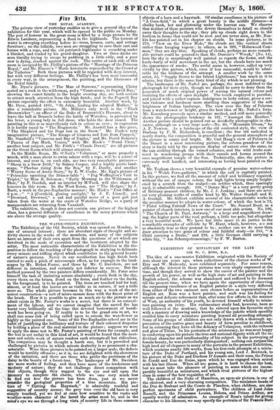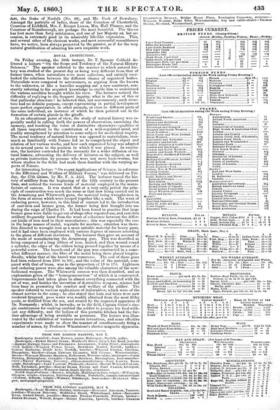EXHIBITION OF MINIATURES BY THE LATE SIR 1V. C. ROSS,
R. A.
The idea of a one-master Exhibition originated with the Society of Arts about ten years ago, when collections of the choicer works of W. Etty and W. Mulready, were exhibited separately. For some reason, although the interest in these pictures was very amply expressed at the time, and though they served to show the career of the painter and the growth of his power, as well as the high state of art and painting in the English school, the .scheme was abandoned and suffered to lie dormant till the present time, when we have again the opportunity of observing the surpassing excellence of an English painter in a style very different from either of the two eminent men chosen before as representatives of English art. Ross was a born painter, and such was his feeling for minute and delicate refinement that, after some few efforts in the manner of West, an authority of his youth, he devoted himself wholly to minia- ture painting on ivory. His rudimentary study had, however, been so well followed at the academy, that he entered upon his favourite style with a mastery of drawing and a knowledge of the palette which speedily enabled him to carry miniature painting beyond all preceding attempts. Some of his groups of children are not only drawn with a thorough ap- preciation of the native grace and beauty of form peculiar to childhood, but in colouring they have all the delicacy of Velasquez, with the richness and glow of Titian. In his portraits of the aristocracy, he was most happy in conferring upon his picture the true and national dignity with all the in- dividual character and intellectuality of his subject. In the portraying of female beauty, he was particularly distinguished ; nothing can surpass the high bred air of elegance in many of the portraits in the present Exhibition, which contains nearly 200 works, from his first rude attempts at a minia- ture of the Duke of Portland, and his young son, Lord J. Bentinek, to his picture of the Duke and Duchess D'Aumale and their sons, the Prince de Conde and Due de Guise, upon which he was engaged when seized with his last illness. When all are gems, it is hard to choose the best, but we must take the pleasure of pointing to some which are incom- parably beautiful as miniatures, and which rival pictures of the highest class in some of the best requisites of art. The children of the Duke of Hamilton, an open-air picture, is one of the choicest, and a very charming composition. The miniature heads of the Due de Brabant and the Comte de Flandres, when children, are also perfect specimens of child portraiture. The children of Lord John Russell, and the Princesses Louisa, Helena, and Prince Arthur; are equally worthy of admiration. As example of Ross's talent for giving character to bis likeness, we may specify the portraits of Sir Francis Bur-
deft, the Duke of Norfolk (No. 28), and _Mr. Cook of Dewsbury. Amongst the portraits of ladies, those of the Countess of Chesterfield, Countess of Lichfield, Mrs. J. Bennet Lawes Mrs. Hall Plumer and the Countess of Gainsborougb, are perhaps the most beautiful. The Queen has lent more than forty miniatures, and one of her Majesty on her ac- cession, is extremely good in its admirably life-like expression. This, and several other of the choicest works, and most successful resemblances have, we notice, been always preserved by the painter, as if for the very natural gratification of admiring his own exquisite work.



























 Previous page
Previous page